Strength Loss Inference Due to Decay or Cavities in Tree Trunks Using Tomographic Imaging Data Applied to Equations Proposed in the Literature
Abstract
:1. Introduction
2. Materials and Methods
2.1. Samples
2.2. Methodology
2.2.1. Ultrasound Tests on Standing Trees
2.2.2. Tomographic Imaging from Standing Tree Data
2.2.3. Preparation of Specimens
2.2.4. Calculation of the Wood Stiffness Coefficient Taken from Different Regions of the Cross-Sections
2.2.5. Determination of Data to Be Applied in Equations Proposed in the Literature
2.2.6. Calculations of Moments of Inertia Considering the Internal Cavity Centered and Noncentered on the Cross-Sections
2.2.7. Application of Data (Cross-Sections and Images) to Calculate the Stiffness Loss Considering the Centered and Noncentered Internal Cavities
2.2.8. Proposition of an Equation including the Strength Loss of the Deteriorated Area
3. Results
4. Discussion
5. Conclusions
Author Contributions
Funding
Data Availability Statement
Acknowledgments
Conflicts of Interest
References
- Biondi, D.; Reissman, C.B. Evaluation of the Vigor of Urban Trees through Quantitative Parameters. Sci. Florest. 1997, 52, 17–28. [Google Scholar]
- Gonçalves, W.; Stringheta, A.C.O.; Coelho, L.L. Analysis of urban trees for suppression purposes. Rev. Soc. Bras. Arborização Urbana 2007, 2, 1–19. [Google Scholar]
- Matteny, H.; Clark, J. Tree risk assessment: What we know (and what we do not know). ISA 2009, 19, 28–33. [Google Scholar]
- Schallenberger, L.S.; Araujo, A.J.; Araujo, M.N.; Deiner, L.J.; Machado, G.O. Evaluation of the condition of urban trees in the main parks and squares in the city of Irati-PR. Rev. Soc. Bras. Arborização Urbana 2010, 5, 105–123. [Google Scholar] [CrossRef]
- Sucomine, N.M.; Sales, A. Characterization and analysis of the tree heritage of the central urban road network in the city of São Carlos-SP. Rev. Soc. Bras. Arborização Urbana 2010, 5, 128–140. [Google Scholar]
- Smiley, E.T.; Matheny, N.; Lilly, S. Qualitative Tree Risk Assessment. Arborist News 2012, 20, 12–17. [Google Scholar]
- Freitas, W.K.; Magalhães, L.M.S. Methods and Parameters for the Study of Vegetation with emphasis on the arboreal stratum. Floresta E Ambiente 2012, 19, 520–540. [Google Scholar] [CrossRef]
- Teixeira, I.F.; Figueiredo, F.M.; Taborda, I.G.R.; Soares, L.M. Phytosociological analysis of Mércio Camilo square in historical center of São Gabriel, RS. Rev. Soc. Bras. Arborização Urbana 2016, 11, 1–13. [Google Scholar] [CrossRef]
- Silva, I.R.; Oliveira, A.T.S.; Silva, L.B.O.; Baia, R.S.; Correa, T.B.C.; Martins, W.B.R. Visual diagnosis and phytosociology in the urban squares afforestation in the city of Paragominas, Pará. Rev. Soc. Bras. Arborização Urbana 2018, 13, 1–13. [Google Scholar]
- Klein, R.W.; Koeser, A.K.; Hauer, R.J.; Hansen, G.; Escobedo, F.J. Risk Assessment and Risk Perception of Trees: A Review of Literature Relating to Arboriculture and Urban Forestry. Arboric. Urban For. 2019, 45, 23–33. [Google Scholar] [CrossRef]
- Giacomazzi, M.; Silva, E.F.L.P.; Hardt, E. Diagnosis of urban trees on neighborhoods in the municipality of Tietê. Rev. Ra’e Ga 2020, 47, 35–48. [Google Scholar] [CrossRef]
- Duarte, A.P.C.; Daniluk-Mosquera, G.; Gravina, V.; Vallejos-Barra, O.; Ponce-Donoso, M. Tree Risk Assessment: Component analysis of six visual methods applied in an urban park, Montevideo, Uruguay. Urban For. Urban Green. 2021, 59, 127005. [Google Scholar] [CrossRef]
- Nicolotti, G.; Socco, L.V.; Martinis, E.; Godio, A.; Dambuelli, L. Application and comparison of three tomographic techniques for detection of decay in trees. Arboric. J. 2003, 29, 66–78. [Google Scholar] [CrossRef]
- Gilbert, E.; Smiley, E. Picus sonic tomography for the quantification of decay in white oak (Quercus alba) and hickory (Carya spp.). J. Arboric. 2004, 30, 277–281. [Google Scholar]
- Wang, X.; Alisson, B.R. Decay Detection in Red Oak Trees Using a Combination of Visual Inspection, Acoustic Testing, and Resistance Microdrilling. Arboric. Urban For. 2008, 34, 1–4. [Google Scholar] [CrossRef]
- Brazee, N.; Marra, R.E.; Goecke, L.; Wassenaer, P.V. Nondestructive assessment of internal decay in three hardwood species of northeastern North America using sonic and electrical impedance tomography. Forestry 2011, 84, 33–39. [Google Scholar] [CrossRef] [Green Version]
- Rust, S. Reproducibility of Stress Wave and Electrical Resistivity Tomography for Tree Assessment. Forests 2022, 13, 295. [Google Scholar] [CrossRef]
- Rinn, F.; Schweingruber, F.H. Resistograph and X-ray Density Charts of Wood. Comparative Evaluation of Drill Resistance Profiles and X-ray Density Charts of Different Wood Species. Holzforschung 1996, 50, 303–311. [Google Scholar] [CrossRef]
- Isik, F.; Li, B. Rapid assessment of wood density of live trees using the Resistograph for selection in tree improvement programs. Can. J. For. Res. 2003, 33, 2426–2435. [Google Scholar] [CrossRef]
- Lima, J.T.; Sartório, R.C.; Trugilho, P.F.; Cruz, C.R.; Vieira, R.S. Use of the resistograph for Eucalyptus wood basic density and perforation resistance estimative. Sci. For. 2007, 75, 85–93. [Google Scholar]
- Rinn, F. Intact-decay transitions in profiles of density-calibratable resistance drilling devices using long thin needles. Arboric. J. 2016, 38, 204–217. [Google Scholar] [CrossRef]
- Gao, S.; Wang, X.; Wiemann, M.C.; Brashaw, B.K.; Ross, R.J.; Wang, L. A critical analysis of methods for rapid and nondestructive determination of wood density in standing trees. Ann. For. Sci. 2017, 74, 27. [Google Scholar] [CrossRef] [Green Version]
- Vlad, R.; Zhiyanski, M.; Dinc, L.; Sidor, C.G.; Constandache, C.; Pei, G.; Ispravnic, A.; Blaga, T. Assessment of the density of wood with stem decay of Norway spruce trees using drill resistance. Comptes Rendus L’académie Bulg. Des Sci. Sci. Math. Nat. 2018, 71, 1502–1510. [Google Scholar] [CrossRef]
- Reis, M.N.; Gonçalves, R.; Garcia, G.H.L.; Manes, L. Profiles of a Non-Calibrated Resistance Drill Compared with Deteriorated Stem Cross Sections. Arboric. Urban For. 2019, 45, 1–9. [Google Scholar] [CrossRef]
- Gillies, J.A.; Lancaster, N.; Nickling, W.G.; Crawley, D.M. Field determination of drag forces and shear stress partitioning effects for a desert shrub (Sarcobatus vermiculatus, Greasewood). J. Geophys. Res. Atmos. 2000, 105, 24871–24880. [Google Scholar] [CrossRef]
- Smiley, E.T.; Kane, B. The effects of pruning type on wind loading of Acer rubrum. Arboric. Urban For. 2006, 32, 33. [Google Scholar] [CrossRef]
- Gardiner, B.; Berry, P.; Moulia, B. Wind impacts on plant growth, mechanics and damage. Plant Sci. 2016, 245, 94–118. [Google Scholar] [CrossRef] [PubMed]
- Gonçalves, R.; Linhares, C.S.F.; Yojo, T. Drag Coefficient in Urban Trees. Trees 2020, 35, 01951. [Google Scholar] [CrossRef]
- James, K.R.; Haritos, N.; Ades, P.K. Mechanical stability of trees under dynamic loads. Am. J. Bot. 2006, 93, 1522–1530. [Google Scholar] [CrossRef]
- Chan, W.C.; Cui, Y.; Jadhav, S.J.; Khoo, B.C.; Lee, H.P.; Lim, C.W.C.; Gobeawan, L.; Wise, D.J.; Ge, Z.; Poh, H.J.; et al. Experimental study of wind load on tree using scaled fractal tree model. Int. J. Mod. Phys. B 2020, 34, 2040087. [Google Scholar] [CrossRef]
- Jackson, T.D.; Sethi, S.; Dellwik, E.; Angelou, N.; Bunce, A.; Van Emmerik, T.; Duperat, M.; Ruel, J.C.; Wellpott, A.; Van Bloem, S.; et al. The motion of trees in the wind: A data synthesis. Biogeosciences 2021, 18, 4059–4072. [Google Scholar] [CrossRef]
- Moore, J.; Maguire, D.A. Natural sway frequencies and damping ratios of trees: Concepts, review and synthesis of previous studies. Trees 2004, 18, 195–203. [Google Scholar] [CrossRef]
- Wagener, W.W. Judging Hazard from Native Trees in California Recreational Areas: A Guide for Professional Foresters; Pacific Southwest Forest and Range Experiment Station, Forest Service, US Department of Agriculture: Berkeley, CA, USA, 1963; pp. 1–29. [Google Scholar]
- Coder, K.D. Should you or shouldn’t you fill tree hollows? Grounds Maint. 1989, 24, 68–72. [Google Scholar]
- Smiley, E.T.; Fraedrich, B.R. Determining strength loss from decay. Arboric. J. 1992, 18, 201–204. [Google Scholar]
- Mattheck, C.; Kubler, H. Wood: The Internal Optimization of Trees; Springer: Berlin, Germany, 1995. [Google Scholar]
- Ciftci, C.; Kane, B.; Brena, S.F.; Arwane, S.R. Loss in moment capacity of tree stems induced by decay. Trees 2014, 28, 517–529. [Google Scholar] [CrossRef]
- Burcham, D.C.; Brazee, N.J.; Marra, R.E.; Kane, B. Can Sonic Tomography Predict Loss in Load-Bearing Capacity for Trees with Internal Defects? A Comparison of Sonic Tomograms with Destructive Measurements. Trees 2019, 33, 681–695. [Google Scholar] [CrossRef]
- Kane, B.; Ryan, D.; Bloniarz, D.V. Comparing Formulas that assess strength loss due to decay in trees. J. Arboric. 2001, 27, 78–86. [Google Scholar]
- Reis, M.N. Association of Nondestructive Methods for Tree Inspection. Master’s Thesis, University of Campinas—UNICAMP, Campinas, Brazil, 2017. [Google Scholar]
- Palma, S.S.A. Pattern Recognition in Ultrasound Generated Images. Master’s Dissertation, University of Campinas—UNICAMP, Campinas, Brazil, 2017. [Google Scholar]
- Du, X.; Li, S.; Li, G.; Feng, H.; Chen, S. Stress Wave Tomography of Wood Internal Defects using Ellipse-Based Spatial Interpolation and Velocity Compensation. BioResources 2015, 10, 3948–3962. [Google Scholar] [CrossRef]
- Feng, H.; Li, G.; Fu, S.; Wang, X. Tomographic image reconstruction using an interpolation method for tree decay detection. BioResources 2014, 9, 3248–3263. [Google Scholar] [CrossRef]
- Zeng, L.; Lin, J.; Huang, L. Interference resisting design for guided wave tomography. Smart Mater. Struct. 2013, 22, 055017. [Google Scholar] [CrossRef]
- United States Department of Agriculture (USDA). Wood and Timber Assessment Manual, 2nd ed.; United States Department of Agriculture (USDA): Madison, WI, USA, 2014. [Google Scholar]
- Keunecke, D.; Sonderegger, W.; Pereteanu, K.; Luthi, T.; NIiemz, P. Determination of young’s and shear moduli of common yew and Norway spruce by means of ultrasonic waves. Wood Sci. Technol. 2007, 41, 309–327. [Google Scholar] [CrossRef] [Green Version]
- Gonçalves, R.; Trinca, A.J.; Cerri, D.G.P. Comparison of elastic constants of wood determined by ultrasonic wave propagation and static compression testing. Wood Fiber Sci. 2011, 43, 64–75. [Google Scholar]
- Vázquez, C.; Gonçalves, R.; Bertoldo, C.; Baño, V.; Veja, A.; Crespo, J.; Guaita, M. Determination of the mechanical properties of Castanea sativa Mill. using ultrasonic wave propagation and comparison with static compression and bending methods. Wood Sci. Technol. 2015, 49, 607–622. [Google Scholar] [CrossRef]
- Bucur, V. Acoustics of Wood, 2nd ed.; Springer: New York, NY, USA, 2006. [Google Scholar]
- Haygreen, J.G.; Bowyer, J.L. Forest Products and Wood Science. An Introduction, 2nd ed.; Iowa State University: Ames, IA, USA, 1995. [Google Scholar]
- Hassan, K.T.S.; Horacek, P.; Tippner, J. Evaluation of Stiffness and Strength of Scots Pine Wood Using Resonance Frequency and Ultrasonic Techniques. BioResources 2013, 8, 1634–1645. [Google Scholar] [CrossRef] [Green Version]
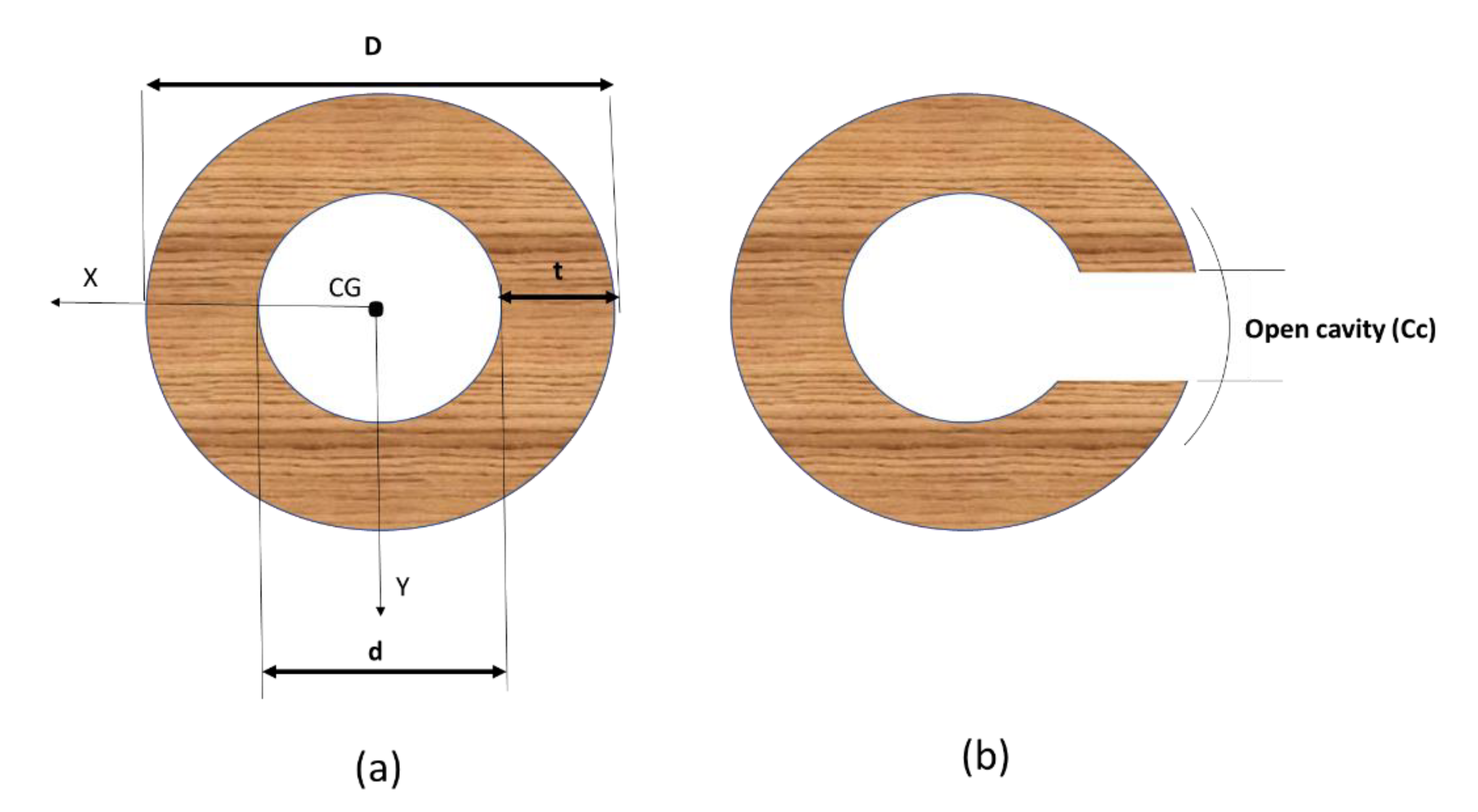
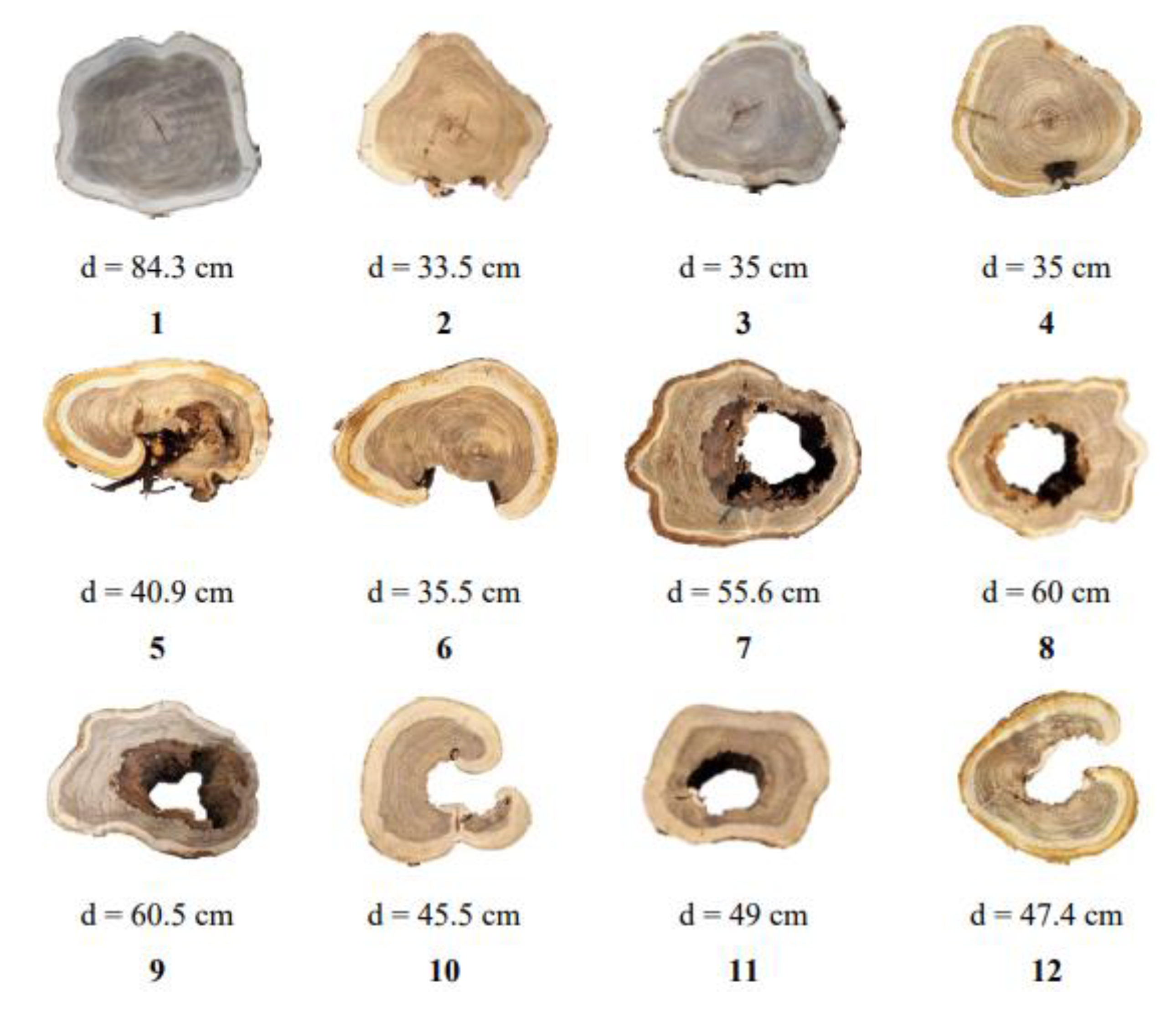
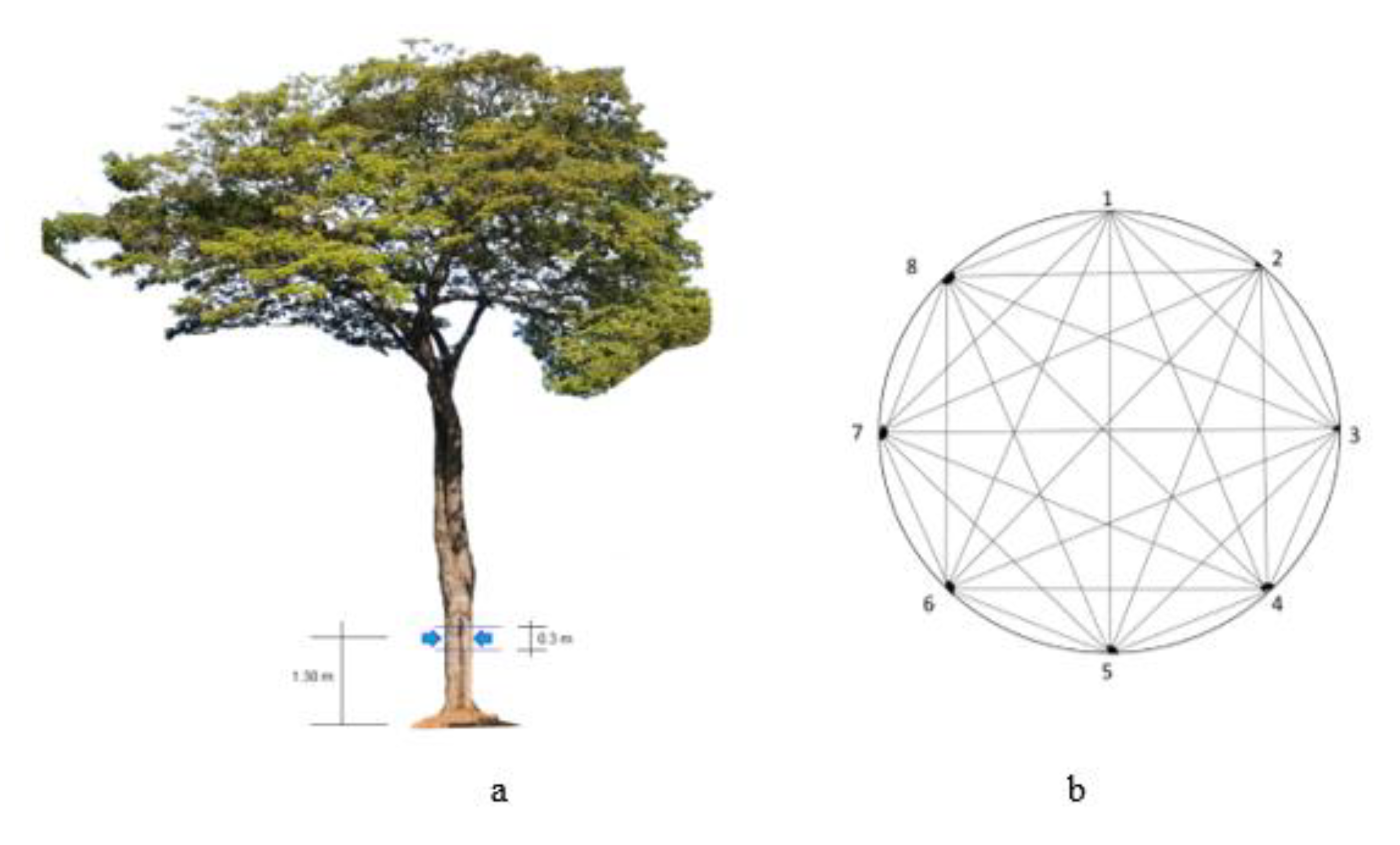
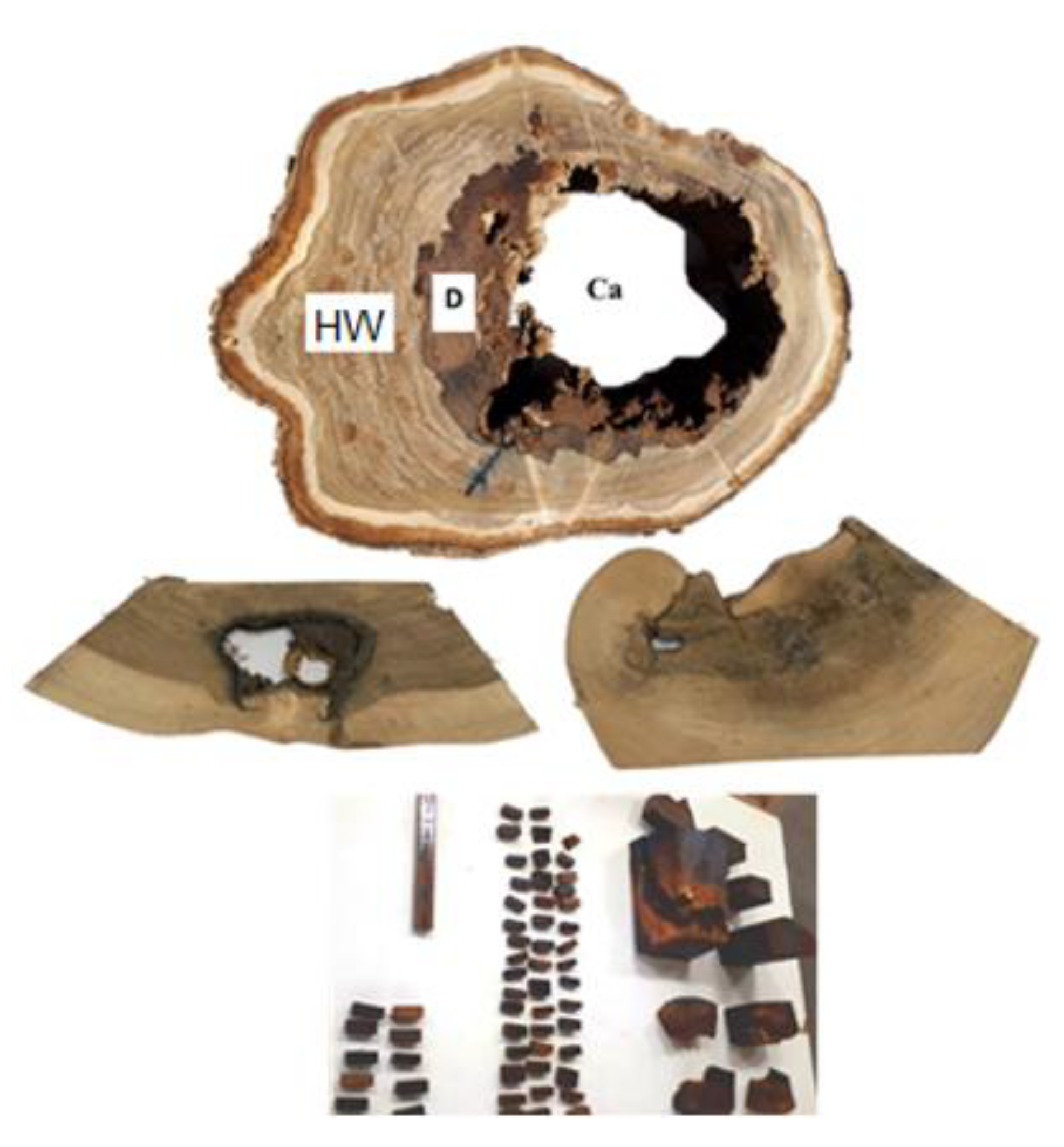
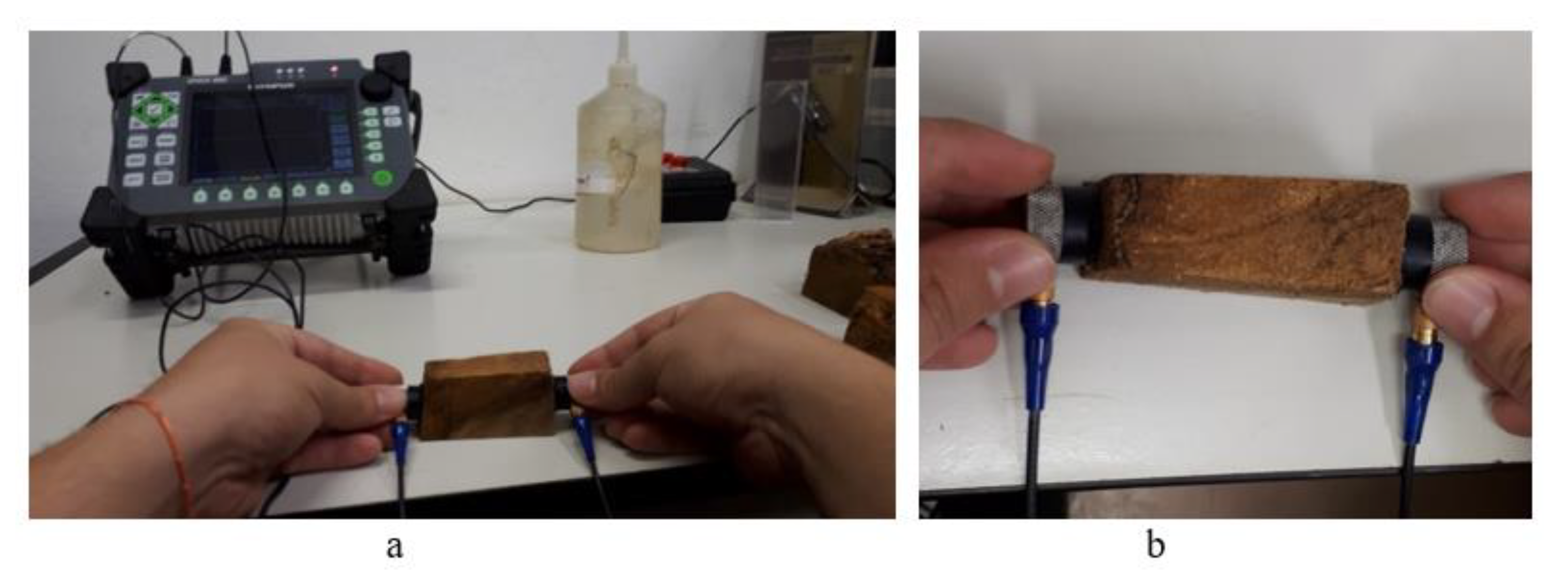
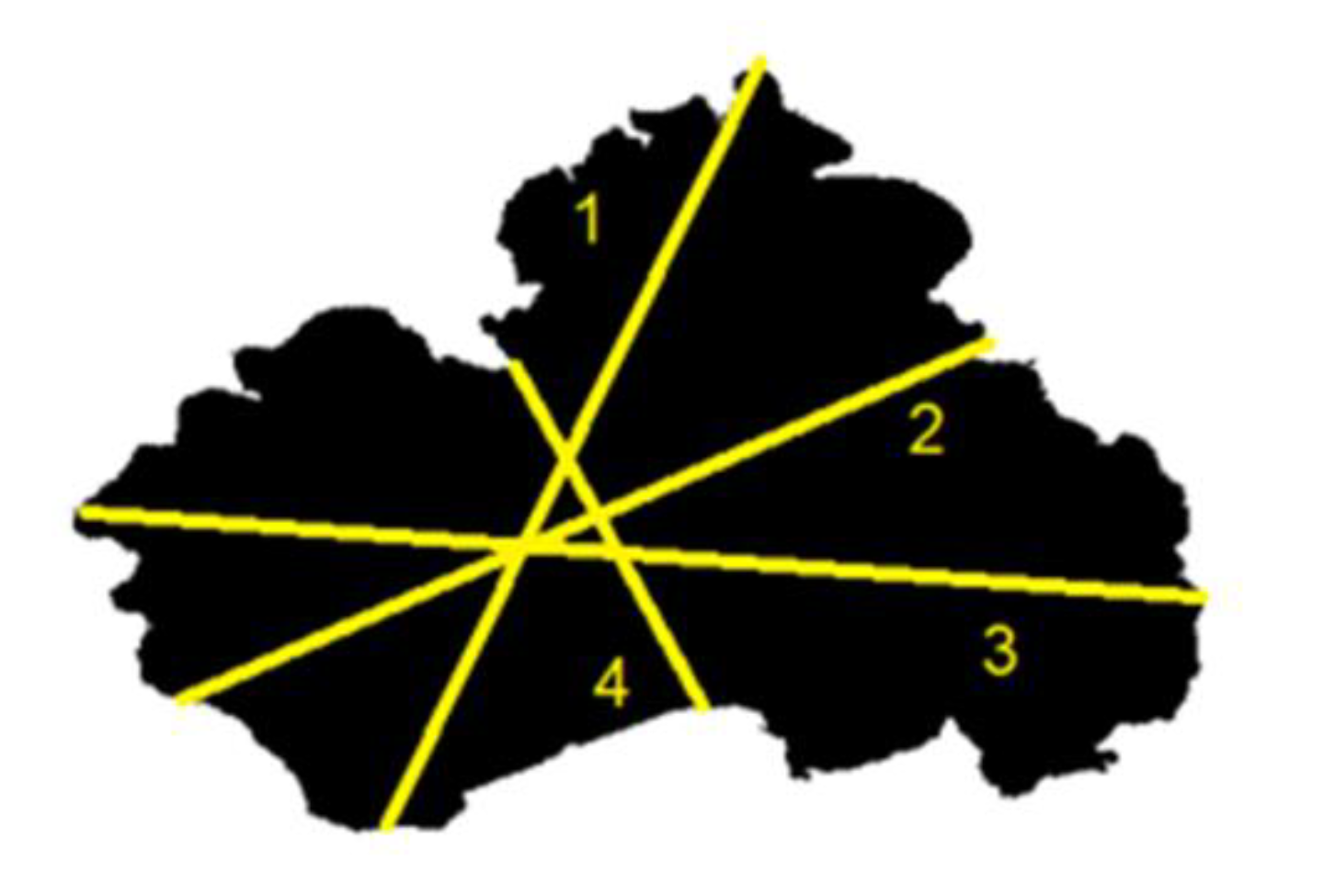
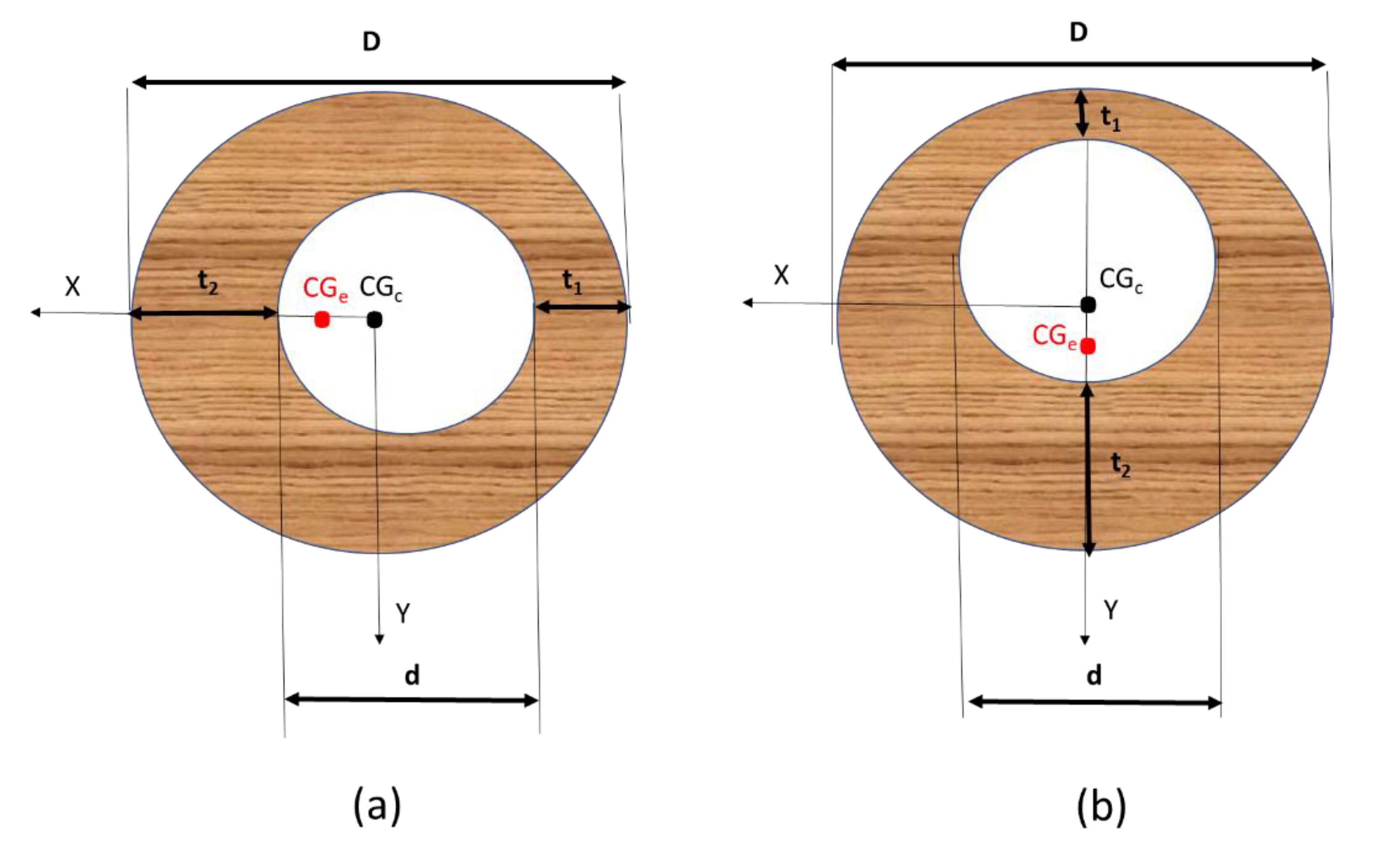
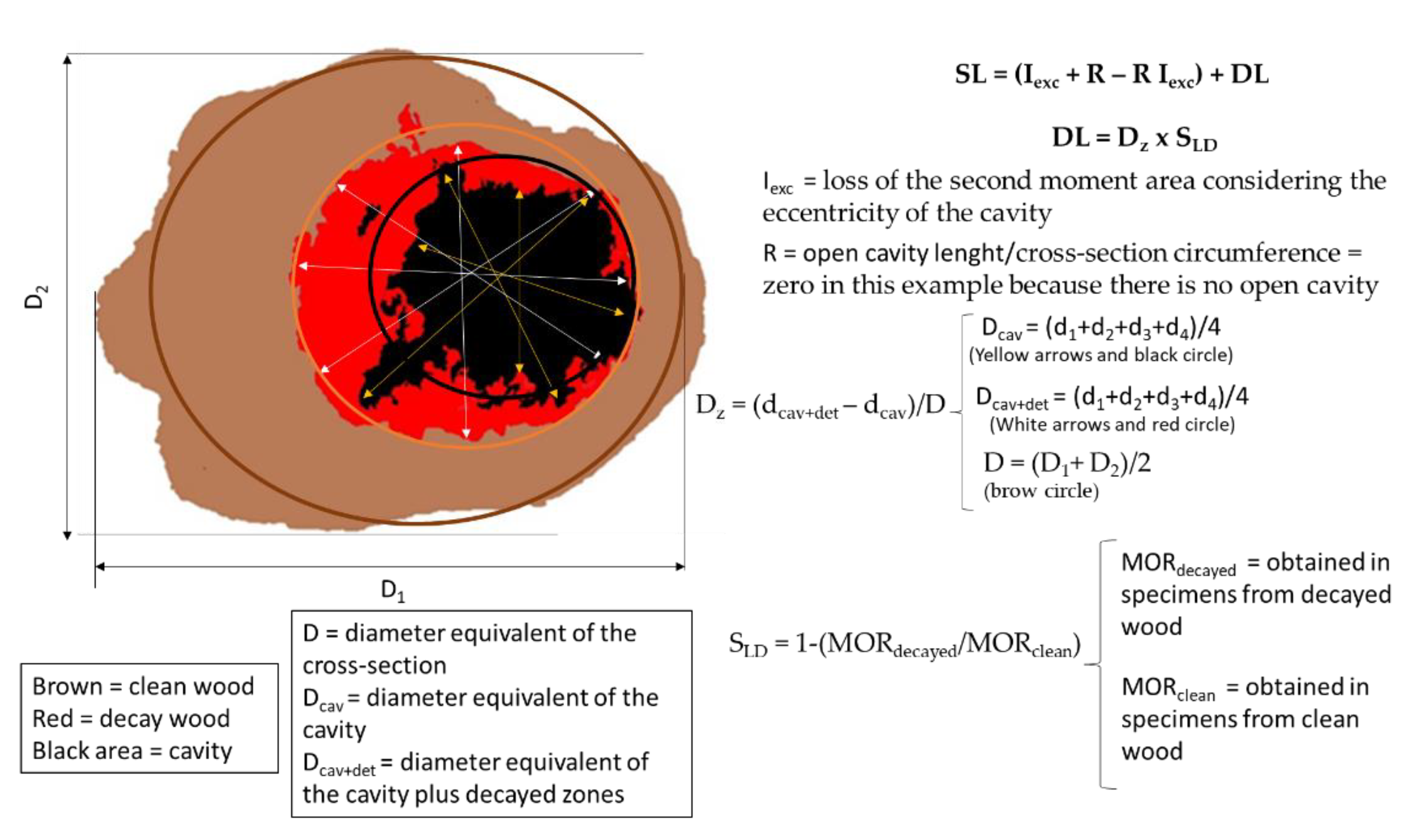
| Cross- Section | Photo | Values Referring to the Actual Condition of the Cross-Sections-Photo | Tomographic Image | Values Referring to Tomographic Images | ||||||||||||
|---|---|---|---|---|---|---|---|---|---|---|---|---|---|---|---|---|
| Cc | dcav | Dcav + Det | D | R | t | Rs | Cc | dcav | Dcav + Det | D | R | t | Rs | |||
| 1 |  | 0 | 0 | 0 | 60.3 | 0 | - | 30.1 |  | 0 | 7.1 | 13.6 | 60.3 | 0 | - | 30.1 |
| 2 |  | 18.5 | 0 | 0 | 30.8 | 0.13 | - | 15.4 |  | 0 | 0 | 15.3 | 30.8 | 0 | - | 15.4 |
| 3 |  | 0 | 0 | 0 | 32 | 0 | - | 16 |  | 0 | 0 | 0 | 32 | 0 | - | 16 |
| 4 |  | 0 | 0 | 4.8 | 32 | - | 16 |  | 0 | 0 | 0 | 32 | 0 | - | 16 | |
| 5 |  | 4.5 | 10.4 | 18.2 | 30.2 | 0.04 | 0 | 15.1 |  | 13.7 | 13 | 19.2 | 30.2 | 0.12 | 0 | 15.1 |
| 6 |  | 14.1 | 0 | 0 | 28.8 | 0.14 | 0 | 14.4 |  | 11.5 | 0 | 12.5 | 28.8 | 0.11 | 0 | 14.4 |
| 7 |  | 0 | 21.9 | 29.9 | 43.9 | 0 | 5.71 | 24.7 |  | 0 | 19.8 | 24.1 | 49.3 | 0 | 8.8 | 24.7 |
| 8 |  | 0 | 21.8 | 30.4 | 53 | 0 | 14.71 | 26.5 |  | 0 | 24.2 | 28.3 | 53 | 0 | 11.9 | 26.5 |
| 9 |  | 0 | 24.5 | 29.8 | 55 | 0 | 5.92 | 27.5 |  | 0 | 22.7 | 38.4 | 55 | 0 | 7.3 | 27.5 |
| 10 |  | 8 | 17.2 | 21.8 | 42.3 | 0.06 | 0 | 21.1 |  | 11.3 | 17.6 | 24.7 | 42.3 | 0.08 | 0 | 21.1 |
| 11 |  | 0 | 17.3 | 17.3 | 45.2 | 0 | 12.03 | 22.6 |  | 0 | 13.7 | 18.2 | 45.3 | 0 | 18.2 | 22.6 |
| 12 |  | 8.6 | 17.8 | 17.8 | 45.2 | 0.06 | 0 | 22.6 |  | 12.8 | 23.4 | 26 | 45.2 | 0.08 | 0 | 22.6 |
| Regression Model | p Value | R2 | Source |
|---|---|---|---|
| Data from the Cross-Sections | |||
| SL = 0.94 Ca2 − 0.49 Ca + 0.072 | 0.0000 | 0.99 | [29] |
| SL = 1.19 Ca2 − 0.47 Ca + 0.061 | 0.0000 | 0.99 | [30] |
| Data from the tomographic images | |||
| SL = 1.24 Ca2 − 0.50 Ca + 0.065 | 0.0000 | 0.99 | [29] |
| SL = 1.04 Ca2 − 0.55 Ca + 0.081 | 0.0000 | 0.99 | [30] |
| Cross-Sections | Cross-Section Data | Tomographic Image Data | ||||||
|---|---|---|---|---|---|---|---|---|
| (2) | (3) | (4) | (5) | (2) | (3) | (4) | (5) | |
| 1 | 0 | 0 | 0 | 0 | 0 | 0 | - | |
| 2 | 0 | 0 | 13 | 0 | 0 | 0 | - | |
| 3 | 0 | 0 | 0 | 0 | 0 | 0 | - | |
| 4 | 0 | 0 | 0 | 0 | 0 | 0 | - | |
| 5 | 1 | 4 | 8 | 0.00 | 3 | 8 | 19 | 0.00 |
| 6 | 0 | 0 | 14 | 0.00 | 0 | 0 | 11 | 0.00 |
| 7 | 4 | 9 | 9 | 0.23 | 3 | 6 | 6 | 0.36 |
| 8 | 3 | 7 | 7 | 0.56 | 4 | 10 | 10 | 0.45 |
| 9 | 4 | 9 | 9 | 0.22 | 3 | 7 | 7 | 0.27 |
| 10 | 3 | 7 | 12 | 0.00 | 3 | 7 | 15 | 0.00 |
| 11 | 2 | 6 | 6 | 0.53 | 1 | 3 | 3 | 0.80 |
| 12 | 2 | 6 | 11 | 0.00 | 7 | 14 | 21 | 0.00 |
| Considering Centered Cavity | Considering Actual Cavity Position | |||
|---|---|---|---|---|
| Cross-Section | Cross-Section Data | Tomographic Data | Cross-Section Data | Tomographic Data |
| 1 | 0 | 0 | 0 | 4 |
| 2 | 0 | 0 | 0 | 0 |
| 3 | 0 | 0 | 0 | 0 |
| 4 | 0 | 0 | 0 | 0 |
| 5 | 1 | 3 | 24 | 33 |
| 6 | 0 | 0 | 0 | 0 |
| 7 | 4 | 3 | 14 | 7 |
| 8 | 3 | 4 | 3 | 5 |
| 9 | 4 | 3 | 15 | 11 |
| 10 | 3 | 3 | 31 | 32 |
| 11 | 2 | 1 | 3 | 1 |
| 12 | 2 | 7 | 29 | 41 |
| Cross-Section | Cross-Section Data | Tomographic Data |
|---|---|---|
| 1 | 0 | 4 |
| 2 | 13 | 0 |
| 3 | 0 | 0 |
| 4 | 0 | 0 |
| 5 | 27 | 41 |
| 6 | 14 | 11 |
| 7 | 14 | 7 |
| 8 | 3 | 5 |
| 9 | 15 | 11 |
| 10 | 35 | 37 |
| 11 | 3 | 1 |
| 12 | 33 | 38 |
| Cross-Sections | Cross-Section Data | Tomographic Data |
|---|---|---|
| 1 | 0 | 8 |
| 2 | 13 | 17 |
| 3 | 0 | 0 |
| 4 | 0 | 0 |
| 5 | 36 | 48 |
| 6 | 14 | 17 |
| 7 | 19 | 10 |
| 8 | 8 | 8 |
| 9 | 18 | 21 |
| 10 | 39 | 43 |
| 11 | 3 | 4 |
| 12 | 39 | 40 |
Publisher’s Note: MDPI stays neutral with regard to jurisdictional claims in published maps and institutional affiliations. |
© 2022 by the authors. Licensee MDPI, Basel, Switzerland. This article is an open access article distributed under the terms and conditions of the Creative Commons Attribution (CC BY) license (https://creativecommons.org/licenses/by/4.0/).
Share and Cite
dos Reis, M.N.; Gonçalves, R.; Brazolin, S.; de Assis Palma, S.S. Strength Loss Inference Due to Decay or Cavities in Tree Trunks Using Tomographic Imaging Data Applied to Equations Proposed in the Literature. Forests 2022, 13, 596. https://doi.org/10.3390/f13040596
dos Reis MN, Gonçalves R, Brazolin S, de Assis Palma SS. Strength Loss Inference Due to Decay or Cavities in Tree Trunks Using Tomographic Imaging Data Applied to Equations Proposed in the Literature. Forests. 2022; 13(4):596. https://doi.org/10.3390/f13040596
Chicago/Turabian Styledos Reis, Mariana Nagle, Raquel Gonçalves, Sérgio Brazolin, and Stella Stoppa de Assis Palma. 2022. "Strength Loss Inference Due to Decay or Cavities in Tree Trunks Using Tomographic Imaging Data Applied to Equations Proposed in the Literature" Forests 13, no. 4: 596. https://doi.org/10.3390/f13040596
APA Styledos Reis, M. N., Gonçalves, R., Brazolin, S., & de Assis Palma, S. S. (2022). Strength Loss Inference Due to Decay or Cavities in Tree Trunks Using Tomographic Imaging Data Applied to Equations Proposed in the Literature. Forests, 13(4), 596. https://doi.org/10.3390/f13040596






